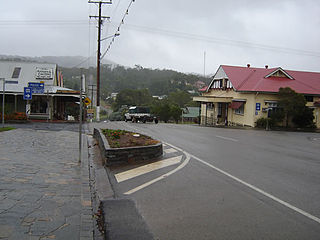
Tutchone is an Athabaskan language spoken by the Northern and Southern Tutchone First Nations in central and southern regions of Yukon Territory, Canada. Tutchone belongs to the Northern Athabaskan linguistic subfamily and has two primary varieties, Southern and Northern. Although they are sometimes considered separate languages, Northern and Southern Tutchone speakers are generally able to understand each other in conversation, albeit with moderate difficulty.

Yungaburra is a rural town and locality in the Tablelands Region, Queensland, Australia. In the 2021 census, the locality of Yungaburra had a population of 1,272 people.

George Ambrose Lloyd, 1st Baron Lloyd, was a British Conservative politician and colonial administrator who was strongly associated with the "Diehard" wing of the party. From 1937 to 1941, he was chairman of the British Council in which capacity he sought to ensure support for Britain's position during the Second World War.

Herberton is a rural town and locality in the Tablelands Region, Queensland, Australia. In the 2021 census, the locality of Herberton had a population of 895 people.

Malanda is a rural town and locality in the Tablelands Region, Queensland, Australia. In the 2021 census, the locality of Malanda had a population of 2,000 people. The economy is based upon agriculture and tourism.

Elections Yukon is an independent agency that oversees elections and plebiscites in the Yukon including:
The 1920 Yukon general election was held on February 25, 1920, to elect the three members of the Yukon Territorial Council. The number of councilors was reduced from ten in the previous election to three following the general decline in population since the Klondike Gold Rush. The council held an advisory role to the federally appointed Commissioner.
The 1922 Yukon general election was set to be held on September 11, 1922. The results of the election were known on August 12, 1922 when all three electoral districts returned members to the Yukon Territorial Council by acclamation. The council played an advisory role to the federally appointed Commissioner.
The 1925 Yukon general election was held on 7 September 1925 to elect the three members of the Yukon Territorial Council. The council was non-partisan and had merely an advisory role to the federally appointed Commissioner.
The 1937 Yukon general election was held on 27 August 1937 to elect the three members of the Yukon Territorial Council. The council was non-partisan and had merely an advisory role to the federally appointed Commissioner.
The 1940 Yukon general election was held on 25 November 1940 to elect the three members of the Yukon Territorial Council.
The 1955 Yukon general election was held on 28 September 1955 to elect the five members of the Yukon Territorial Council. The council was non-partisan and had merely an advisory role to the federally appointed Commissioner.
The 1961 Yukon general election was held on 11 September 1961 to elect the seven members of the Yukon Territorial Council. The council was non-partisan and had merely an advisory role to the federally appointed Commissioner.
The 1964 Yukon general election was held on 8 September 1964 to elect the seven members of the Yukon Territorial Council. The council was non-partisan and had merely an advisory role to the federally appointed Commissioner.
The 1949 Yukon general election was held on 25 July 1949 to elect the three members of the Yukon Territorial Council. The council was non-partisan and had merely an advisory role to the federally appointed Commissioner.
The Yukon Territorial Council was a political body in the Canadian territory of Yukon, prior to the creation of the Yukon Legislative Assembly. Although not a full legislature, the council acted as an advisory body to the Commissioner of Yukon, and had the power to pass non-binding motions of legislation which would be forwarded to the commissioner for consideration.
The Saint Cyr Range is a remote mountain range in the Yukon, Canada. It has an area of 6224 km2 and is a subrange of the Pelly Mountains which in turn form part of the Yukon Ranges.
The Wolf Hunters is a 1949 American Northern film directed by Budd Boetticher and starring Kirby Grant, Jan Clayton and Edward Norris. It was based on the novel of the same title by James Oliver Curwood, which had previously been adapted in 1926 as The Wolf Hunters and in 1934 as The Trail Beyond starring John Wayne, Noah Beery, Sr. and Noah Beery, Jr. The film was the second in a series of ten films featuring Kirby Grant as a Canadian Mountie.
Willard Leroy "Deacon" Phelps was a Canadian politician, lawyer and businessman. He was a member of the Yukon Territorial Council from 1909 to 1920, 1925 to 1934 and 1940 to 1943, and the owner and manager of the first hydroelectricity company in Yukon.
Mount Atherton is a mountain in Canada. It is located in the province of Yukon, in the western part of the country, 4,100 km west of the capital Ottawa. The peak of Mount Atherton is 1,892 metres above sea level, or 625 metres above the surrounding terrain. The width at the base is 12.2 km. It was named after Charles Thomas Atherton, who succeeded Deacon Phelps as a member of the Yukon Territorial Council, representing Whitehorse from 1934 to 1937.





